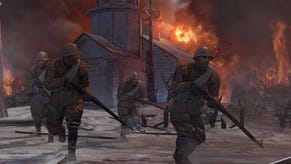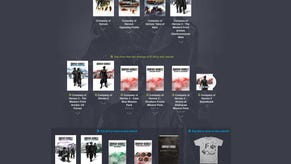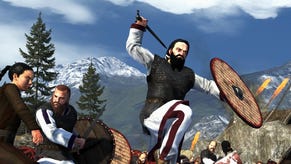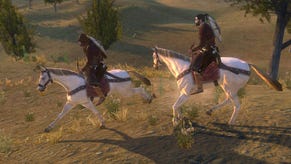A cold day in Hell: Company of Heroes 2 moves east
Relic Entertainment demonstrated the sequel to one of the highest-rated RTS games ever made at THQ’s pre-E3 showcase last week. Stace Harman's impressions and a video developer interview inside.
To claim a videogame offers a realistic depiction of its subject matter would be a hubristic oxymoron, but a videogame can certainly present an authentic interpretation of an experience. Based on the in-depth presentation and gameplay demonstration exhibited by Relic Entertainment, Company of Heroes 2 is wringing every last drop of authenticity from the harshest and bloodiest front of World War II.
Some context for those that may have missed the original game: Company of Heroes is a World War II RTS title that launched to critical acclaim in 2006. The game’s relative age and the franchise’s long hiatus from the spotlight seems to have done little to dent its popularity: Relic claims that following the official announcement of Company of Heroes 2 the original game hit its highest number of peak concurrent users in its six year history. What this translates to is an IP with a loyal and hungry fan base but, more importantly, it points to a franchise that stands as the go-to example for those that have never been interested in real-world, real-time strategy games.
Having created a best-in-class WWII RTS, it seems certain folly to follow it up with another one, for how can the sequel hope to have the same impact as the first? Relic specialises in RTS titles and the developer has already shown its flair for imagination with its work on both the Dawn of War series set in the fantastical world of Warhammer 40,000 and the similarly sci-fi focused Homeworld, so shouldn’t the team turn its hand to another conflict?
"I found this hard to believe when I went back and looked at it, but with the original Company of Heroes titles we covered four months of World War II,” recalls game director Quinn Duffy. “That’s from the invasion on the beaches of Normandy in June through to September of 1944; just four months of a six year war. That leaves a lot to be explored, no least an area where Germany lost around 80% of its combat fatalities; an area that we didn't touch in the first game."
The Eastern Front
Stalin’s order 227 is infamous for its brutality and indicative of the last-stand mentality that typified the Eastern front conflict. The crux of order 227, that there would be “not a step back”, was not mere rhetoric: it was reinforced by sanctions that decreed that no matter what lay ahead, any man that retreated without a direct order to do so would be branded both a coward and traitor of his country and risked being shot by his own comrades.
"This was brutal warfare,” says Duffy. “There was a real need for control that led to the creation of things like order 227; that really sets the tone in a situation where countries were essentially trying to avoid complete elimination."
The wider campaign narrative is told through the eyes of an ex-soldier who returns to the front lines as a war correspondent. In a further bid for authenticity, Relic is in talks to license the contents of a book written by a Russian soldier who fought in the conflict, which it hopes will form the basis of its story.
Relic intends that this attention to detail will bolster its attempt to convey the mentality of the Soviet forces, as well as the desperation and resolve that led to the seemingly inhumane treatment of its own soldiers. It hopes to portray the circumstances and conditions of the conflict in such as way so as to be both unflinching and sensitive, something that initially sounds like a contradiction.
“The whole conflict was brutal and we want to portray that in a way that doesn't shy away from the reality of what happened."
“The whole conflict was brutal and we want to portray that in a way that doesn't shy away from the reality of what happened,” says Relic general manager Alex Peters. “We don't want to hide from that brutality, but we want to be able to deliver a sense of how hard it was without doing the Hollywood ‘over the top’ thing. So, through the campaign we're going to have the player choose between different options, and sometimes none of those options are good.”
It’s this approach that leads Relic to strive to strike yet another balance, one that illustrates the differences between the two armies involved while making the gameplay interesting and engaging. On the one hand, there is the Soviet army, which Duffy likens to a blunt instrument, “Stalin talks about quantity having a quality all of its own and that's really a part of the design of the Soviet army ... not one single hammer; but millions of hammers, pounding their way to Berlin.”
Conversely, the German army is better trained, touts more advanced weaponry and relies more on the abilities of its forces to fight the numbers of the Red army. At this stage, Relic is withholding precise details about the campaign and whether the conflict will also be experienced from a German perspective, saying only that both forces will be available in multiplayer.
In addition to contending with each other, both sides must also endure the unrelenting force of Russia’s harsh weather conditions, which are dynamically rendered by Relic’s propriety Essence3 engine. Snow has a depth that makes its traversal a gameplay consideration, while visibility will often be poor. This is a factor that Relic is highlighting with its true-sight feature, which Duffy describes as “moving away from soldiers punching a perfect little circle in the fog of war” and instead towards lines of sight that shift and flow to adapt to obstacles and terrain of the battlefield.
True-sight’s biggest contribution to game play is that it facilitates ambushes, sneak attacks and flanking in ways that were not possible in the original Company of Heroes. In the gameplay Relic shows, a Soviet convoy unwittingly trundles into the sights of a company of German fighters lying in ambush with anti-vehicle firepower.
The crew of an open-top, anti-personnel Soviet unit is killed in the subsequent shelling, which leaves the vehicle unmanned and leads to it becoming the focal point of a flash-skirmish as both sides fight to gain control of it. It’s instances like this that Relic intends will serve as smaller, dynamic confrontations within the overarching objectives.
"It's about immersion and engagement, one of the things we do is focus on those front-line heroes and that dynamic tactical gameplay," explains Duffy.
"We want to be able to immerse the player in some of that authenticity and provide an emotional experience; we want to be judged on the authenticity, accuracy and tone of the experience.”
Relic’s message throughout the presentation and gameplay demonstration is clear: to provide an authentic experience and try to convey the ferocity and magnitude of some of the bloodiest conflicts of World War II.
We’ll find out next year if Relic’s passion for its subject matter translates into a game that can live up to its predecessor, but it seems the choice to further explore this bleak period of modern history was an easy one to make, "We didn't want to do different,” says Duffy. “We wanted to do more."
Company of Heroes 2 is slated for a PC release in early 2013.











